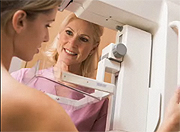
MONDAY, April 15 (HealthDay News) — The drugs tamoxifen and raloxifene (Evista) could reduce the risk of breast cancer among women who are at high risk of developing the disease, a new report confirms.
Along with the report, the U.S. Preventive Services Task Force also issued draft recommendations that reflect those findings, which will be published in the April 16 issue of the Annals of Internal Medicine.
The task force recommendations state that doctors should talk about the potential benefits and harms of taking drugs to prevent breast cancer, a strategy known as chemoprevention, with patients who are at high risk of developing breast cancer.
That guideline is consistent with that of the American College of Obstetricians and Gynecologists and the American Cancer Society, and reflects current clinical practice, the task force said.
“We had a nice set of well-done, large [studies], so we have a lot of confidence in the results to really inform the recommendations,” said report author Dr. Heidi Nelson, a research professor of medical informatics and clinical epidemiology at the Oregon Health and Science University in Portland. Nelson and the other report authors are not task force members and were contracted by the panel to analyze and summarize the latest research for the report.
One of the report’s key findings was that studies of tamoxifen reported a decrease in breast cancer incidence from 23.5 per 1,000 women in the placebo group to 16.5 per 1,000 among women taking tamoxifen over a five-year period. Nelson and her colleagues arrived at these numbers by analyzing four studies of women who took tamoxifen for about four years and their rates of breast cancer over the following seven to 13 years.
Another advance since the 2002 recommendations is a 2010 study that compared tamoxifen and raloxifene directly. “Tamoxifen is more effective at reducing breast cancer risk, but it has more side effects,” Nelson said. In this study, there were five fewer cancers per 1,000 women taking tamoxifen when compared with raloxifene.
For both drugs, the benefits have to be weighed against the potential harms, Nelson said. “The tricky part is finding the right candidate” who is at increased risk of breast cancer and has a low risk of experiencing adverse events from the medications, she added.
The report looked at the rates of adverse events such as blood clots, which was about 90 percent more likely in studies of women taking tamoxifen and 60 percent more likely among women taking raloxifene. For tamoxifen, 8.6 per 1,000 women experienced a blood clot compared with 4.6 per 1,000 in the “control” group.
The rates of endometrial cancer, or cancer of the uterus, and cataracts were also higher for women taking tamoxifen, but not for those taking raloxifene, compared with their respective control groups.
In addition, “some women have side effects that are not life-threatening but they are uncomfortable and not minor, and cause them to stop medications, such as vaginal discharge, dryness, itching, leg cramps,” Nelson explained.
Tamoxifen is currently approved by the U.S. Food and Drug Administration to reduce the risk of breast cancer among women at increased risk who are 35 years and older, whereas raloxifene is only approved for this use in postmenopausal women.
These medications are taken as a once-a-day pill and women are recommended to take them for five years, Nelson said. Raloxifene is also approved to prevent or treat osteoporosis, and for those uses women take the medication for a longer period of time, she noted.
Despite the fact that these medications have been available for a long time — tamoxifen was approved for breast cancer chemoprevention in 1998 — studies suggest they are underused. Only 60,000 women in the United States used tamoxifen in 2005, down from 120,000 in 2000, even though at least 2 million could be eligible for it.
Part of the problem could be that it is difficult for doctors to predict which patients are at high risk for developing breast cancer, Nelson explained. The FDA uses a risk assessment tool called the Gail model, which takes into consideration age, race, medical history and other factors, to define a woman’s risk level, but even this model is not necessarily a good predictor for an individual patient, Nelson said.
The most important factors for determining risk of developing breast cancer are increased age, family history and having had a biopsy that showed signs of precancers, Nelson said.
One expert said he expected the report to stimulate a new look at this use of these medications.
“These drugs work, this is an effective chemoprevention regimen,” said Robert Smith, senior director of cancer screening at the American Cancer Society in Atlanta.
Another reason that these drugs could be underused is that, as women age, they are more likely to see an internist or primary care physician than a gynecologist, and these types of doctors could be less likely to have a conversation about breast cancer chemoprevention, Smith said.
“The task force update is likely to stimulate some action among primary care physicians,” Smith said.
Even though patients’ concerns about side effects could also factor into the underuse of tamoxifen and raloxifene, most women do decide to take one of the drugs if their doctors recommend it, Smith said. The current report found that 70 percent of women took the recommended treatment dose.
The adverse effects of blood clots, endometrial cancer and cataracts are less likely if women take these drugs at a relatively young age, Nelson said. However, the risks might be too high for women who have a history of blood clots or cataracts, she added.
The reduced risk among young women “really does suggest that the period of time to actively assess risk and consider chemoprevention is not long after menopause” and even as women make the transition into menopause, Smith said.
Although the studies included in this report did not find a decrease in breast cancer mortality, it could be that it will take longer follow-up times to see a difference, Nelson said.
It could also be the fact that these drugs only reduce the risk of a type of breast cancer called hormone receptor-positive breast cancer and that survival is better for this type of breast cancer, Nelson said. Tamoxifen and raloxifene work by interfering with estrogen, which drives the growth of breast cancer in hormone receptor-positive cancers.
More information
To learn more about breast cancer risk and the Gail model, visit the U.S. National Cancer Institute Breast Cancer Risk Assessment Tool.

